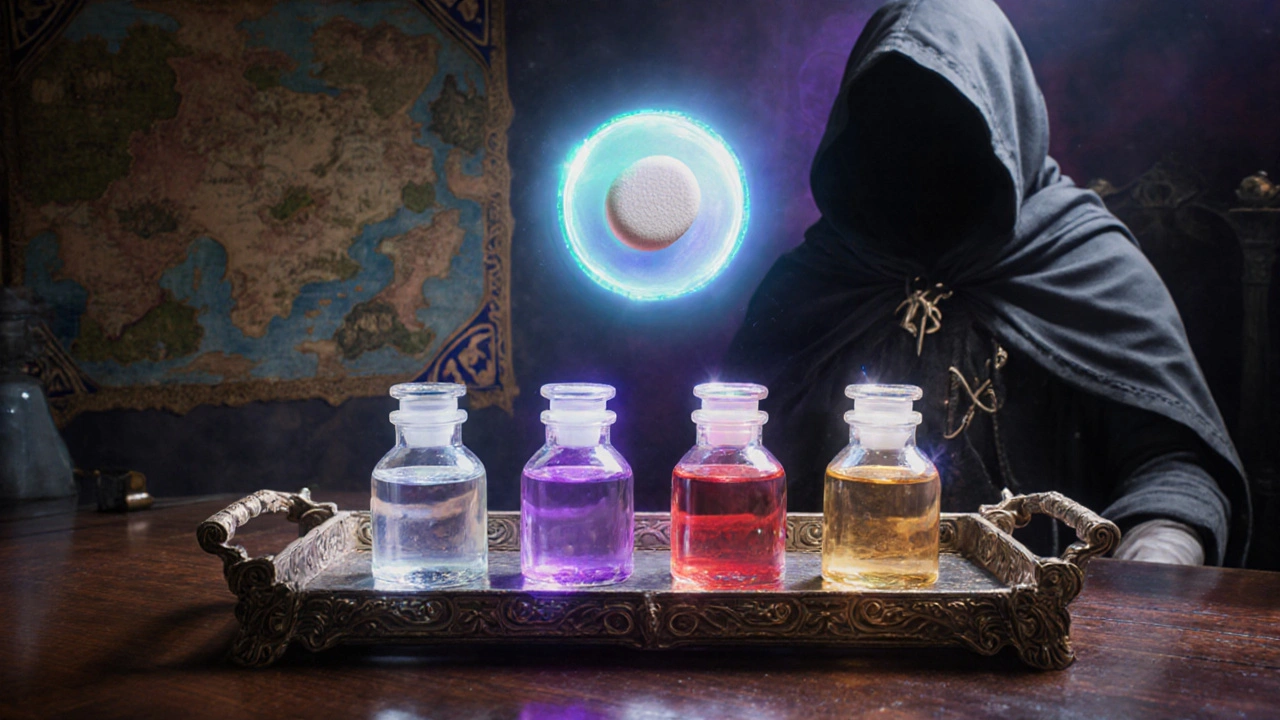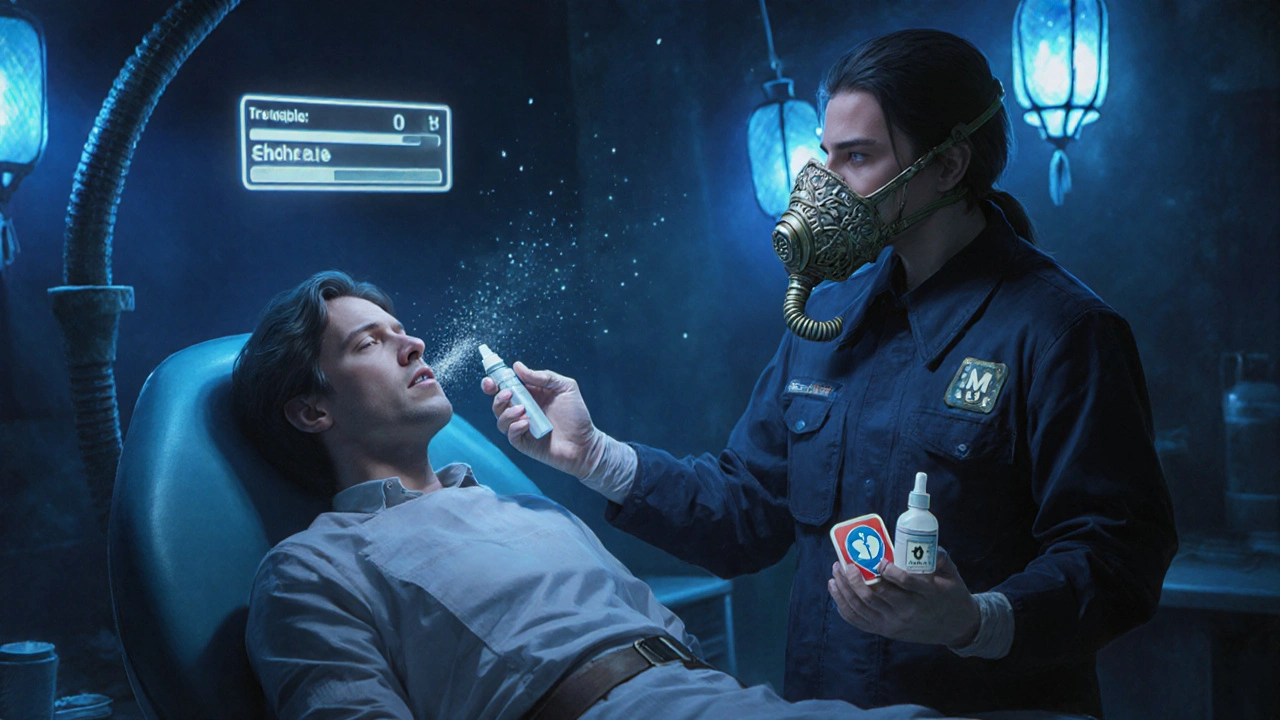Zolmitriptan Dental Anesthetic Safety Checker
Your Medical Profile
Anesthetic Safety Results
Recommended Anesthetics
Anesthetics to Avoid
When a migraine‑relief pill meets a dental chair, a few questions pop up: Is it safe to take my usual dose? Will the dentist’s anesthetic interfere with the medicine? How can a sudden headache be handled mid‑procedure? This guide answers those concerns by breaking down what Zolmitriptan is, how it works, and what both patients and dentists should do before, during, and after a dental visit.
What Is Zolmitriptan and How Does It Work?
Zolmitriptan is a prescription medication classified as a triptan, used primarily to abort migraine attacks. It binds to serotonin (5‑HT1B/1D) receptors, narrowing dilated blood vessels in the brain and blocking pain pathways. Typical adult dosing ranges from 2.5mg to 5mg, taken as a tablet, orally disintegrating tablet, or nasal spray. Peak plasma levels appear within 1-2hours, and the drug’s half‑life is about 3hours, meaning its effects fade relatively quickly compared with older migraine treatments.
Why Dental Care and Zolmitriptan Need Special Attention
Dental procedures often involve local anesthetics that contain epinephrine (a vasoconstrictor), nitrous oxide sedation, or oral sedatives. Each of these agents can interact with the cardiovascular effects of triptans:
- Vasoconstriction: Both zolmitriptan and epinephrine narrow blood vessels. In patients with underlying heart disease or hypertension, the combined effect could raise blood pressure or provoke cardiac strain.
- Serotonin syndrome risk: While rare, combining triptans with certain serotonergic agents used for anxiety or depression (e.g., SSRIs) can trigger serotonin syndrome. Dentists should be aware if a patient is on such drugs.
- Respiratory considerations: Nitrous oxide can cause mild vasodilation, which generally balances out but may alter migraine perception for some patients.
Understanding these interactions helps dentists choose the safest anesthetic plan and lets patients know when to pause or adjust their medication.
Key Guidelines for Patients
Before you book your next cleaning or root canal, run through this quick checklist:
- Inform the dental office that you take zolmitriptan. Write it down on a medication list.
- Ask if the planned anesthesia contains epinephrine. If you have a history of cardiovascular disease, request a formulation without a vasoconstrictor (e.g., plain lidocaine).
- Schedule your migraine medication at a time that won’t clash with the appointment. If you usually take a dose right before a stressful event, consider delaying it until after the visit, unless your dentist advises otherwise.
- Bring a backup plan for sudden migraine onset during the procedure-e.g., a fast‑acting nasal spray you can self‑administer.
- Keep a record of any past adverse reactions when you’ve taken zolmitriptan with dental anesthetics. This helps the clinician tailor the approach.

Best Practices for Dentists
Dental professionals can minimize risk by following these steps:
- Medication Review: During the medical history intake, specifically ask about triptans, SSRIs, MAO inhibitors, and any cardiovascular conditions.
- Choose the Right Anesthetic: For patients on zolmitriptan, consider using lidocaine without epinephrine, or low‑dose epinephrine (1:200,000) if vasoconstriction is essential for hemostasis and the patient has no heart issues.
- Monitor Vital Signs: Check blood pressure and heart rate before administering any vasoconstrictor. Re‑check after injection, especially for longer procedures.
- Prepare Emergency Supplies: Have oxygen, nitroglycerin, and an antihypertensive agent on hand in case of hypertensive spikes.
- Communicate Clearly: Explain the plan to the patient, including why a vasoconstrictor‑free option is being used and how to signal if they feel a migraine coming on.
Comparison of Local Anesthetic Options for Zolmitriptan Users
| Anesthetic | Vasoconstrictor? | Typical Dose | Pros for Zolmitriptan Patients | Cons / Precautions |
|---|---|---|---|---|
| Lidocaine 2% plain | No | 1-2mL per site | Lowest cardiovascular impact; safe with triptans | Shorter duration, may need re‑injection for lengthy work |
| Lidocaine 2% with 1:200,000 epinephrine | Yes (low dose) | 1-2mL per site | Extended anesthesia, better hemostasis | Potential additive vasoconstriction; avoid if patient has hypertension or heart disease |
| Articaine 4% with 1:100,000 epinephrine | Yes (moderate dose) | 0.5-1mL per site | Deep penetration, useful for posterior teeth | Higher vasoconstrictor level; contraindicated for high‑risk cardiac patients on zolmitriptan |
| Prilocaine 4% plain | No | 1-2mL per site | Good alternative for patients allergic to lidocaine; minimal cardiovascular effect | Risk of methemoglobinemia at high doses; monitor total volume |
Managing a Migraine Attack During a Dental Visit
If a migraine erupts midway through a procedure, here’s a practical plan for both parties:
- Patient Action: Stop the procedure if possible, inform the dentist immediately, and use a fast‑acting zolmitriptan formulation (e.g., nasal spray) if allowed.
- Dentist Action: Pause, provide a quiet, dimly lit environment, and offer supplemental oxygen if appropriate. Avoid administering additional vasoconstrictors until the migraine subsides.
- Post‑procedure Follow‑up: Schedule a brief check‑in after the visit to assess any lingering symptoms and adjust future medication timing.

Safety Checklist for the Dental Appointment
| Item | Completed? |
|---|---|
| Notify dentist of zolmitriptan use | |
| Provide list of all current meds (including SSRIs, antihypertensives) | |
| Ask about vasoconstrictor‑free anesthetic options | |
| Confirm blood pressure is within normal range | |
| Plan for rapid migraine relief (nasal spray ready) | |
| Discuss emergency protocol with dentist |
Common Concerns Addressed
Will taking zolmitriptan increase bleeding during extraction? No. Zolmitriptan does not affect platelet function. Bleeding risk is mainly linked to anticoagulants, not triptans.
Can I receive nitrous oxide sedation while on zolmitriptan? Generally yes. Nitrous oxide has minimal cardiovascular impact, but discuss any history of severe migraines with the dentist.
Is it safe to have a crown placed after a migraine attack? If you’re feeling stable and your blood pressure is normal, proceeding is fine. However, scheduling non‑urgent work for a day after a migraine can improve comfort.
Bottom Line
Knowing how zolmitriptan interacts with dental drugs lets you and your dentist create a safe, comfortable treatment plan. Communicate openly, choose the right anesthetic, and have a quick‑action migraine plan ready. With these steps, a routine dental visit doesn’t have to become a migraine‑triggering event.
Frequently Asked Questions
Can I take my regular dose of zolmitriptan on the day of a dental cleaning?
Yes, for low‑impact procedures like cleanings you can usually keep your usual dose. Just inform the dentist so they can select an anesthetic without epinephrine if you have any heart‑related concerns.
Is a vasoconstrictor‑free anesthetic as effective as one with epinephrine?
For short procedures, plain lidocaine works fine. For longer or more invasive work, a low‑dose epinephrine formulation can provide better bleeding control and longer numbness. Discuss the trade‑off with your dentist.
What should I do if I feel a migraine starting during the appointment?
Tell the dentist right away, stop the work if possible, and use a fast‑acting format of zolmitriptan (nasal spray or tablet) as instructed. The dentist can provide a calm environment and pause any further medication administration.
Are there any long‑term risks of mixing triptans with dental sedatives?
Long‑term risk is low. The main concern is the acute additive effect on blood pressure or heart rate if high‑dose epinephrine is used. Choosing lower‑dose or vasoconstrictor‑free options mitigates this.
Should I avoid nitrous oxide because it can trigger migraines?
Nitrous oxide itself is not a common migraine trigger. Some patients report a slight headache after prolonged exposure, but it’s usually mild. If you’re sensitive, discuss using a lower concentration or an alternative sedation method.

 Pharmacology
Pharmacology
Liam Mahoney
August 21, 2025 AT 14:36Look, if you're on Zolmitriptan you *must* tell your dentist about it-no excuses, no half‑measures. The risks of mixing vasoconstrictors with a triptan aren't something to gamble with, especially if you have any heart history.
surender kumar
August 22, 2025 AT 04:29Oh great, another "just tell them" recipe, as if that magically makes the epinephrine vanish.
Justin Ornellas
August 22, 2025 AT 18:22The pharmacodynamic interplay between zolmitriptan and epinephrine‑laden anesthetics is not a trivial footnote, but a cornerstone of cardiovascular safety. When a 5‑mg dose of zolmitriptan achieves peak plasma concentration within two hours, the serotonergic vasoconstriction is already in full effect. Introducing an additional sympathomimetic agent such as epinephrine can precipitate a synergistic increase in mean arterial pressure. Clinical studies have documented transient hypertensive spikes in patients receiving both agents concomitantly, especially those with pre‑existing hypertension. Therefore, the prudent dentist should either select a plain lidocaine formulation or, if vasoconstriction is indispensable, employ a minimal concentration like 1:200,000. Equally important is the timing of the triptan dose; administering dental anesthesia within three hours of the last zolmitriptan pill maximizes the overlap of vasoconstrictive activity. If a migraine onset is imminent during the procedure, the patient should be instructed to pause the treatment and self‑administer a rapid‑acting nasal spray. The dentist, meanwhile, must cease any further epinephrine administration until the migraine subsides, to avoid compounding the vascular response. From a mechanistic standpoint, serotonin syndrome remains a theoretical risk when triptans are combined with serotonergic antidepressants, but the addition of a vasoconstrictor does not directly precipitate it. Nevertheless, a comprehensive medication review-covering SSRIs, MAO inhibitors, and antihypertensives-remains an ethical obligation. Patients with documented coronary artery disease should be counseled that even low‑dose epinephrine may impose an undue cardiac load. In such high‑risk scenarios, plain prilocaine or a lidocaine‑only solution offers a safe anesthetic alternative. Monitoring vital signs before and after injection is a simple yet often neglected safety net. Finally, having emergency supplies such as nitroglycerin and supplemental oxygen on standby reflects best practice in any office where vasoactive drugs are used. In summary, transparent communication, judicious anesthetic choice, and vigilant timing constitute the triad of safety for zolmitriptan‑using patients.
JOJO Yang
August 23, 2025 AT 08:16Are you serious? I’ve seen dentists slam a whole cartridge of Articaine into a patient with a history of heart trouble and act like it’s no big deal. This kind of reckless confidence should be banned, not applauded.
Shelby Rock
August 23, 2025 AT 22:09i think the whole conversation kinda reminds me of a moral compass spinning when you mix medics and molars. if you’re living with migraines, your body already feels like a battlefield, so a dentist should be a peacekeeper, not a trigger. remember, the smallest choice-like a plain lidocaine-can be the difference between a calm visit and a thunderstorm. respect the chemistry, respect the patient.
Dhananjay Sampath
August 24, 2025 AT 12:02Well said, and to add a little structure: first, always document the patient’s medication list; second, discuss anesthetic options openly; third, monitor vitals before and after injection; and finally, have a contingency plan ready. This approach ensures both safety and confidence for everyone involved.
kunal ember
August 25, 2025 AT 01:56When we examine the literature on triptan‑anesthetic interactions, we encounter a tapestry of case reports, pharmacokinetic models, and randomized trials that together paint a nuanced picture. The consensus, albeit derived from heterogeneous data, suggests that low‑dose epinephrine may be tolerated in otherwise healthy individuals, yet caution is warranted for those with comorbid cardiovascular disease. Moreover, the temporal proximity of zolmitriptan ingestion to dental procedures appears to modulate risk, with the first three hours post‑dose representing the window of maximal vasoconstrictive synergy. Consequently, clinicians are encouraged to schedule non‑urgent, high‑intensity procedures beyond this interval when feasible. In terms of alternative anesthetics, plain lidocaine and prilocaine emerge as viable substitutes, offering sufficient analgesia with minimal systemic impact. Finally, patient education remains paramount: a well‑informed individual can assist in timing medication, recognizing early migraine cues, and communicating any adverse sensations during treatment.
Kelly Aparecida Bhering da Silva
August 25, 2025 AT 15:49Don't you see how the big pharma narrative pushes these vasoconstrictors on us, advertising convenience while ignoring the hidden cardiac toll? It's a classic case of profit over patient safety, and we can't let dental offices become their testing grounds.
Michelle Dela Merced
August 26, 2025 AT 05:42This whole drill feels like a battlefield, and every extra drop of epinephrine is another bomb 💣. If they can't respect our health, they should stay out of the clinic!
Alex Iosa
August 26, 2025 AT 19:36While your metaphor is vivid, the factual data do not support the notion of a deliberate harm campaign; rather, it reflects a complex interplay of pharmacology often misunderstood by the public.
melissa hird
August 27, 2025 AT 09:29Indeed, the dramatics are entertaining, but let us not mistake theatrical flair for scientific rigor; proper protocol, not paranoia, safeguards our smiles.